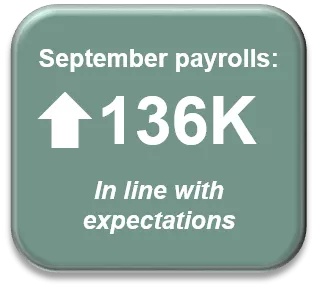October Economic Commentary: A quiet September as economic reports generally meet expectations

Chief Economist
Pohlad Companies
September proved to be a fairly quiet month as it relates to significant market moves or economic announcements. During the month, long-term Treasury yields were relatively steady with the 10-year yield rising 12 basis points from 1.50% to 1.62%. As expected, the Fed Funds rate was reduced at the mid-month meeting of the Federal Open Market Committee (FOMC) from 2.25% to 2.00%. There is a 70% chance that the Fed Funds rate will be reduced to 1.75% at the October 30 meeting of the FOMC. An additional cut in December is also viewed as a high probability.
Economic reports were generally in line with expectations, showing that the U.S. economy is still moving forward but with less vibrancy than earlier in the year. Real GDP in the first half of 2019 advanced 2.6%, but indications are that the second half of 2019 will show growth closer to 1.75%.
The Organization for Economic Cooperation and Development (OECD) cut global economic forecasts, projecting global growth of 2.9% this year—a drop from its 3.2% outlook from four months ago and the slowest pace in a decade.
Housing market strength
One area showing some strength in the late summer was the housing market. Consumers reacted to the 25-basis-point drop in mortgage rates in August by purchasing more homes (both new and existing). Additionally, refinancing of existing mortgages increased. It remains to be seen if this is a trend or a short-term reaction.

September payrolls meet expectations
The September payroll report released in the first week of October showed non-farm payrolls rising 136,000, in line with expectations. The pace of hiring is slowing, however, reflecting a diminishing supply of qualified workers and some hesitancy to hire due to the slowing economy. The unemployment rate fell to 3.5%, the lowest level since 1969. Average hours worked per week remained unchanged at 34.4, but average hourly earnings disappointed by registering no gain from the prior month. Year-over-year earnings growth slowed to 2.9% despite the tight labor supply. Small business expectations for hiring plans fell last month – this is worrisome if it continues.
The manufacturing sector remains under pressure. The recent reading from the Purchasing Managers survey came in at 47.8—the second month in a row below 50, indicating contraction in the manufacturing sector. This was the lowest reading of this survey since June 2009.
Truce in the Trade War
The tensions around the trade issues with China may have gotten a reprieve with last Friday’s announcement of a truce regarding new tariffs that were scheduled to take effect next week in exchange for an assurance of increased purchases of agricultural goods by the Chinese. Details are sketchy, existing tariffs were not included, and more contentious items such as technology security were tabled for later discussion. All in all, a baby step to resolving the trade tension. It is unlikely that this truce alone will substantively change uncertainty enough to impact many business plans, however. With American business reluctant to ramp up capital investment due to trade policy uncertainty and weak global demand, consumer spending in the U.S. (accounting for 70% of GDP) is the primary support for ongoing economic growth in the U.S. A healthy labor market is critical for continued economic growth. Any softening of the labor market will quickly reverberate through the economy. Monitoring the ongoing health of the U.S. labor market, then, is critical in assessing potential future economic activity.
Insights
Research to help you make knowledgeable investment decisions